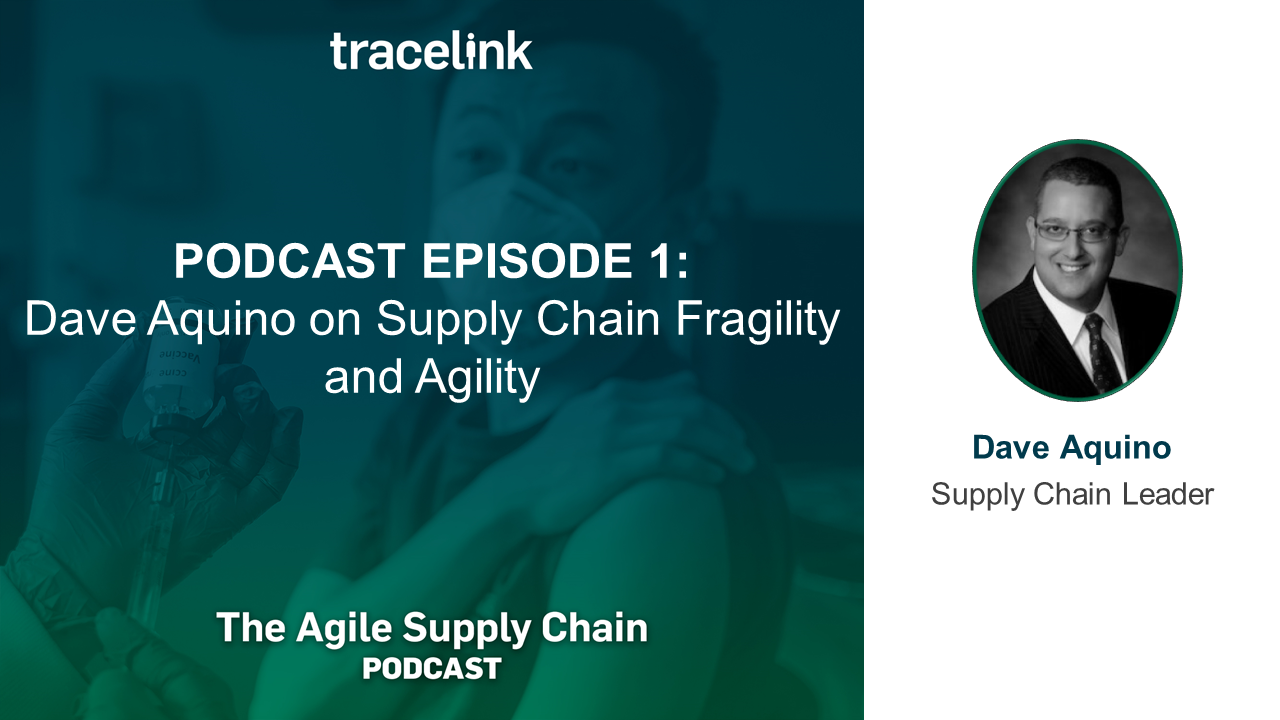Table of contents
Key Takeaways
- COVID-19 revealed a lack of flexibility in the healthcare supply chain, but digital technologies are poised to help the industry increase agility.
- Digital will help to “eliminate friction” between supply chain stakeholders so they can quickly and seamlessly create new partnerships and business processes.

Welcome to The Agile Supply Chain Podcast! In our first episode, TraceLink's Digital Transformation Strategist, Roddy Martin, talks with veteran supply chain leader Dave Aquino about the impact the COVID-19 crisis will have on the future of the healthcare supply chain.
Transcript:
Welcome to The Agile Supply Chain Podcast with your host, Roddy Martin, Digital Transformation Strategist at TraceLink. Today, Roddy welcomes supply chain leader Dave Aquino to talk about supply chain fragility and agility. Let's listen in.
Roddy Martin: Welcome, Dave, to our first podcast featuring supply chain leaders. Very exciting. We've got a really, really good lineup of experienced supply chain leaders to find out where supply chain has gone from yesterday, today, given the pandemic, and tomorrow.
I'm really proud to have Dave as a very experienced supply chain leader, not only with supply chain but with an IT, a business operations background, and other things. Dave, why don't you introduce yourself?
Dave Aquino: Thanks so much, Roddy. Great to be here. I really appreciate getting to join and talk about this series of issues and opportunities today. My name is Dave Aquino. Most recently, I was the chief operating officer and CIO for SharkNinja, a two-billion-dollar home appliance company based in Needham, Massachusetts.
Prior to that role, I was, for six years, the COO and CIO for apparel and uniform company, Barco Uniforms. That was focused half on healthcare as well as the other half on corporate identity and quick service restaurant business. Great to be here.
Roddy: That's fantastic. Dave, given that you were in the PPE space—maybe the bottom end of PPE space—give us some anecdotes. You've recently got re involved in your own operation in PPEs and sourcing. Give us a few anecdotes about how you've seen this from a supply chain point of view.
Certainly, from the outside, the lack of responsiveness in supply chains and the lack of visibility seems to have been a real nightmare. I'm sure it is for you sourcing equipment.
Dave: It's an unprecedented time, as we know. Probably the understatement of the day. The issue has been, to your point, a lack of preparedness and a lack of agility. In the apparel and footwear space, in particular, it's been sourcing and managing very complex supply chains across the world.
There's been an understanding of how to navigate uncertainty, variability, risk, whether you're operating and sourcing in Africa or in Asia. It feels today so frustrating to not be able to have responsiveness and have an integrated supply chain that is providing the personal protective equipment that people need.
I've recently pivoted some of my advisory and startup work to focus on PPEs, specifically, because there has not been an availability. Our expertise in being able to develop new supply chains in countries of origin that are non China and giving options for people has been the need. What we've seen from an anecdote standpoint is an absolute paralysis of being able to get basic supplies.
I'm very excited and appreciative that I've got partners and myself to be able to deploy those capabilities and bring product in that's going to serve the marketplace.
Roddy: Dave, you've also had an interesting set of roles, head of IT, COO in a really serious global operating business that involves a lot of international sourcing and procurement, but also head of supply chain. One of the biggest challenges that we're seeing is bringing those functions together.
Let's add digital into the mix. Talk a little bit about how you see supply chain from the role of a CIO, from the role of digital, from the role of being the supply chain officer, from the role of being in the business. How have you looked at supply chain? It's certainly changed in the last six months.
Dave: It's a great point. The integration and natural affinity for technology enablement, visibility, transparency, it's part and parcel of the core physical management of the supply chain. Today, looking at: How quickly can you deploy new resources? How can you add new capabilities?
As a supply chain leader, as a COO, you need to be simultaneously comfortable in managing the functionality and technology options while thinking about how to build new processes and new relationships. Folks that are trying to pivot and have only traditionally managed one aspect of the supply chain are woefully inadequate to drive success.
Roddy: That's a great point. Enter digital, one of the most amusing scenarios I saw was a leader of a big pharma supply chain company in Europe who stood up and said, "I thought we'd nailed supply chain. Along came digital and now we're all confused." From a digital point of view and as a supply chain leader, how do you see the big opportunity for digital?
Dave: The speed, and visibility, and you talked about track and trace, right now, everybody is counting on existing relationships and virtual handshakes on where are we going to get product. Is it coming in? Do we know where it's coming from? Is it efficacious or not?
This is going to quickly and rapidly transform our traditional supply chains to be able to build a lot more agility globally as well as locally. If you think about 10 weeks into this whole discussion that we still can't get paper towels. We still can't get napkins. People are panicked.
The discussions that I'm having all day long is, who can you count on? Who can you trust? Having direct visibility into the inner workings of manufacturing, distribution, and logistics is a table stakes kind of deal.
We're going to see a pivot point much like we saw in the last recession of this appetite for services and digitization that has never been encountered before.
Roddy: It's changing the whole operating model to a digital one and eliminating a lot of the paper based processes and the long lead times simply because we haven't aligned and synchronized all of our processes. We've been talking about you and I, we're in this together. We've been talking about visibility for years. It's really hit just between the eyes now.
What do you think is one of the big issues around visibility as a supply chain leader? What was most frustrating to you in terms of visibility? Visibility of what? Because visibility isn't something that's actionable unless you know what you're actioning.
Dave: I love that question, Roddy. There's so much to be frustrated about. I'll try to only come up with a couple. Specifically, the visibility that we're encountering today is based on relationships. It's based on physical presence. Our competitive advantage and supply chains globally are predicated on having people on the ground.
To be able to verify the product is being manufactured, that it's being packaged correctly, that the logistics are being managed, that we understand the risk profile for importation. Those are the kinds of things that we're dealing with. That is such an antiquated and anachronistic model.
We need to have visibility from a digital standpoint of what is happening in real time and be able to manage this in a much less brute force manner. That's been the challenge for us currently, is that we need to replace the physical proximity or physical involvement with an augmentation of what's happening on the ground through a global network.
We've talked for a long time about that capability, but boy, do we need it today.
Roddy: We've spoken the words “digital twin.” It sounds so cool, so to speak, in a digital parlance. In essence, what you're saying is, let's create a digital view of the operating business, and let's manage and lead it responsibly from a digital level.
The other point is, when you look at conventional IT, all the ERP systems and the databases that we've got all over the business, haven't those introduced a real serious constraint and complexity to being able to run the N10 business? Now, not only do we have partners not talking to each other, we have systems that don't talk to each other.
We can't see one or more partners upstream or downstream. How do we then track a product all the way from where it was made and packaged all the way into a patient or a shopper's hands?
Dave: Absolutely. What's maddening is that if there was ever a time to eliminate friction between trading partners, create new capabilities and new relationships. It's absolutely paralyzed with the traditional systems in place. It's ironic.
What we're going to find is that the deep experience of supply chain and business leaders is going to surmount a lot of this incapability, yet we desperately need to have systems that allow us to integrate and incorporate new business partnerships, new relationships, fast and seamlessly.
The fact is, big companies, governmental agencies, you're getting emails seven days later saying, "We got your email. We know you have product but we're not sure how to decipher who you are and how to operate. Meanwhile, we've sold 500,000 units of product to all kinds of customers all over the place." That's the difference. It's not just limited to government.
It's a problem for businesses interacting. I'm excited about the opportunity to find new technologies and new capabilities that are going to allow us to run and gun. That's what we need right now.
Roddy: Dave, you're involved in PPEs. We know that the United States, we have a massive military infrastructure. We know that we haven't been able to control visibility. Logistics is a huge issue in getting these PPEs around. What have you seen? What suggestions would you make? What opportunities are there?
Dave: Thank you, Roddy, for that question. It's absolutely debilitating. The one thing that we've seen as supply chain leaders and entrepreneurs is that you need to jump on this and help people solve this problem. Producing product in China is not the only issue. Producing product in China and getting it cost effectively into our country has been ridiculously difficult.
Case in point: The expectation that I would have had as one scenario for the United States with its massive military capabilities and federal control over the airline industry would have been to control pricing to deploy the infrastructure that's available to provide quick airfreight and effective airfreight.
Today, even where you can get product produced and you need it immediately, there is either no capacity to ship, pricing has gone up from roughly $3 a kilogram for airfreight to about $16 per kilogram with no capacity and no options to get that product any faster.
One example in terms of key learnings that we all felt was probably obvious is, when does the federal government get involved in ensuring capacity and price controls under these exigent issues? That's something that we have to learn from. A slow boat doesn't work in this environment.
Roddy: That's interesting. If you had to make a quasi analyst prediction of what you think supply chain's going to look like in 2025, what would you say is going to be different?
Dave: There are several things that I think are really important that we're going to be writing, researching, and learning from this for years to come. A quick example, when we were dealing with the recession, as you recall, in '08 '09, there was a massive inflection point in the receptivity for software-as-a-service and platform-as-a-service because there was no capital to deploy.
Companies did not have the labor. They did not have the investment strategy. That changed the power structure, authenticity, and viability of services. The CIO was not the top dog in the discussion, it was much more about the business leadership. Today, what we're looking at is globally connected, service-oriented, less-monolithic approaches.
It's more about building these relationships quickly, creatively, and sustainably, if that makes sense. The opportunity is this adjustment to: Let's not spend 10 years building an ERP or looking at traditional solutions. We absolutely need to know on the ground what's happening.
Roddy: If you happen to be talking to a younger person who has aspirations of going into supply chain, what advice would you give them? Traditionally, the supply chain leaders have come out of operations and engineering ranks. It's not necessarily wrong but I don't think it gives you an optimal view of the business operating models.
What advice would you give somebody who's looking aspirationally at supply chain as their career?
Dave: There's a lot of people that truly understand supply chain today. You and I have been talking a long time about the discipline and advocating. I've worked a lot with the universities. I'm affiliated on the board with Syracuse University, actually president of that advisory group. It's hard to explain supply chain.
For younger people, everybody understands it today because they can't get basic items. They scratch their heads saying, "In the US, are we really a developing country? Do we actually not have the ability to go from commercial products to retail products, and back and forth?" The beauty of this is that there's so much rich opportunity to be able to develop.
One area that we've been talking about and experiencing for a while is the depth and interest around analytics, around integration, around fact based information. For example, social media connection, my prior organization, we spend a deep amount of work on social media, deciphering that information, and using it for product development and responsiveness.
The same for the whole raft of analytics. That's the engine or the straw that stirs the drink. It's a Trojan Horse for kids and students thinking about this to get into the broader aspects of supply chain. Boy, today, using analytics and getting into the technology allows you to see the complexity and opportunity that we need to fix going forward.
Roddy: I love that perspective. Analytics has traditionally been seen by maybe the more traditional supply chain community as answering those questions we knew the business had. How much? How many? When? How many times did this break? How many times did we miss an order?
To the younger generation coming up through the ranks, analytics seems to come much more intuitively to them. They're looking for patterns in data. They're looking for models. They're looking to answer questions we never even knew we could answer.
I absolutely agree with you that, going forward into the future with all of this data that we have around from all these digital flows, and that's simply going to get more, we can start exploring that and building much more efficient visibility, analytics, understanding of how business models work, getting faster responsiveness of events. It's very exciting to look forward into 2025.
The last point that I want to make on that is, what's interesting is the word “agility” is coming back into the agenda. We've seen agility in the context of lean. We've seen agility in the context of software development. We've seen agility in the context of manufacturing and supply chain.
We're starting to see the agile healthcare supply chain, or the agile supply chain, come back into the fore. What do you understand by agility? What do you think the compelling reason for a company to focus on building agile capabilities is all about?
Dave: I love it. It's such an important point. Think about today, we've pivoted 180 degrees from shopping in store to, basically, that's a suicide mission for many people. The ability to shop online in massive capability has even outstripped the capabilities of Amazon. Try to do Amazon fresh. Try to do any of these systems and the whole structure.
That's funny. Amazon's talking to me. They're everywhere.
Roddy: Amazon's Alexa heard you say Amazon. She thought you wanted to place an order. That's the digital world right in the middle of our webinar.
Dave: That's great. I'll try to use the A word then.
Roddy: [laughs]
Dave: The ironic thing is when you talk about agility and pivot, you talk to a hundred people and they'll say to you, "I shopped. It was painful in terms of being online. I can't determine if anything's in stock. I don't know until the end if stuff's going to get stripped out of my cart, and I don't know when I'm ever going to be able to get an appointment."
From an agility standpoint, when we talk about technology and analytics, certain companies will identify this quickly and change the shopping experience to ensure, for example, that you get a delivery date first, that you are really clearly understanding what product's available, that you're going to be able to get it in a convenient time and cost.
You're going to have visibility into if it's out of stock, when it's going to be in stock. We've been talking about that as time immemorial. That's a very basic, fundamental area. The second part is, I've invested in a 3D printing and manufacturing company.
People don't have basic products. They don't have personalization options. We need to change the manufacturing model to allow a multitude of options. Think about the 3D technology married to true manufacturing, non traditional. That's going to allow us to pivot much faster and respond to these types of events in the future.
We need to have a fundamental rethinking about what's traditional manufacturing, how do we integrate it into new technologies, and enable different global options at the flick of a switch, so to speak.
Roddy: It's so exciting. This is the last point. I really appreciate you, with all your experience, Dave, making time available for us. The last point is, I always advocate to companies in a trusted thought leadership advisor point of view: Think about your supply chain from making product and getting it to the customer in the most efficient way.
When you think about why it's not getting there, think from the patient or the customer with a shelf back to supply. It's such a fundamental issue. We have to teach people how to think from the shopper back. The way you articulated your frustrations as a shopper, you started off with, "Hey, I do the click. This is what I expect to happen."
That's not necessarily how all companies think about their supply chains. They're making tons of stuff. They're shipping it to a place where they think it's going to get sold. They rely on salespeople to get rid of and sell the product. This is, let's figure out what's really needed. Let's figure out what degree of customization. Let's not make waste.
Let's figure that out and rebuild the supply chain from the shelf all the way back to the supply systems. Dave, thank you very much for making your time. This has been enlightening.
Once again, the fact that you've been a CIO, you've run supply chains, you've been a CIO in the business, those sets of unique capabilities brought together to talk about supply chain, that's what makes this so exciting and so alive. Thank you very much for your time.
Dave: Thank you very much, Roddy.
Return to: The Patient-Driven Supply Network






